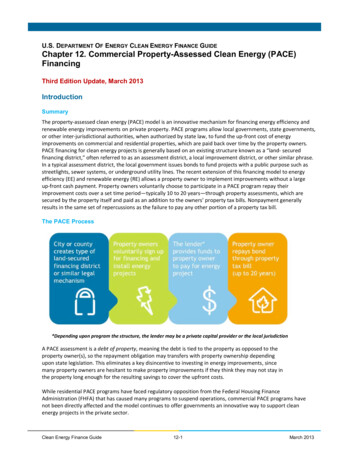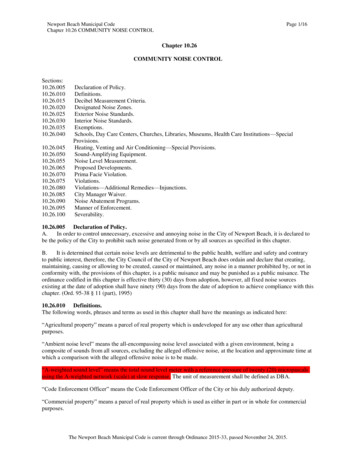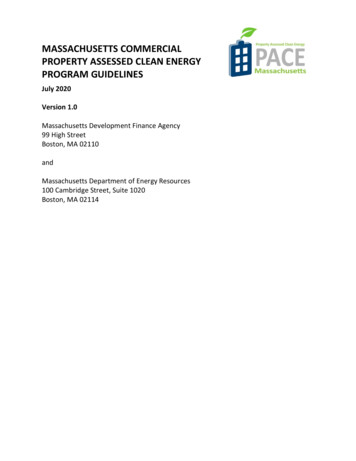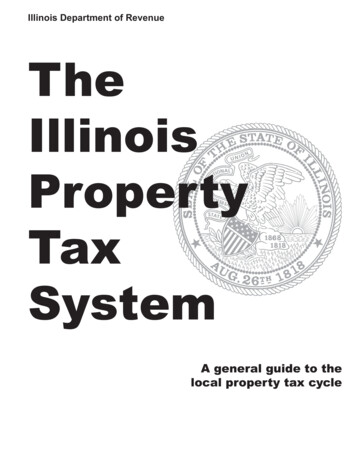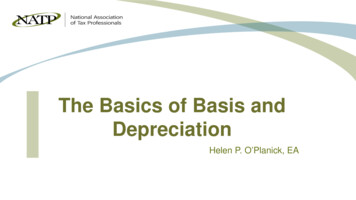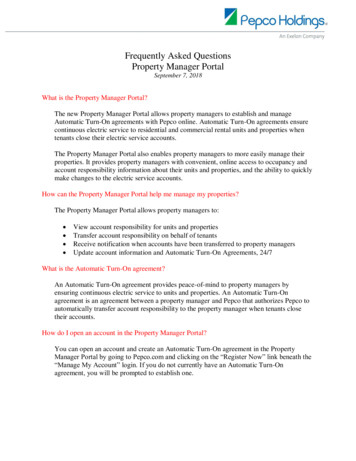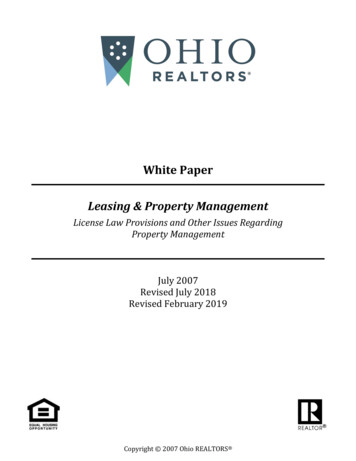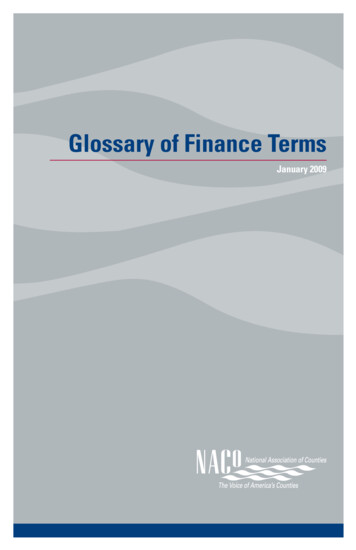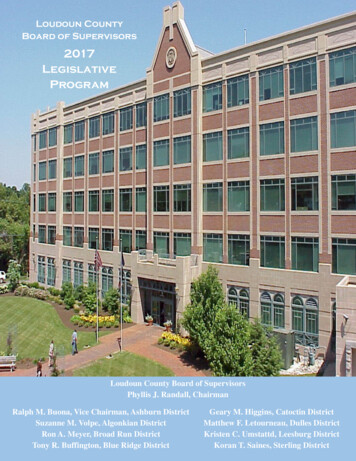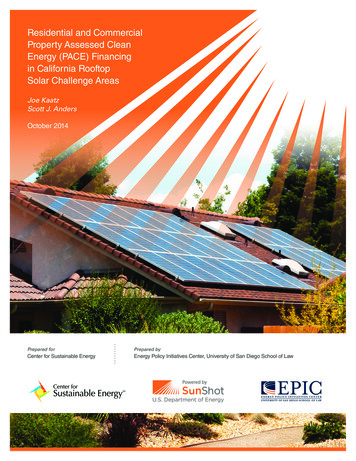
Transcription
Residential and CommercialProperty Assessed CleanEnergy (PACE) Financingin California RooftopSolar Challenge AreasJoe KaatzScott J. AndersOctober 2014Prepared forPrepared byCenter for Sustainable EnergyEnergy Policy Initiatives Center, University of San Diego School of Law
AcknowledgmentsThe authors would like to thank the following individuals for their help in providing information, reviewingdrafts and providing insightful comments and for their advice and counsel during the project.Jane EliasSheila BergerRick BishopSimon BryceRichard ChienCrystal CrawfordCisco DeVriesNathalie Gonzalez NestorKimberly HawleyMike LemyreChris LynchJanill RichardsErik CaldwellBarbara SpoonhourElizabeth WeillDustin ReilichMatt MessinaRick JulianMark AarvigJeremy HutmanMerlan LinaresAaron KlemmSonoma CountySonoma CountyWestern Riverside Council of Governments (WRCOG)Renewable FundingCity of San FranciscoYgrene Energy FundRenewable FundingDesign-Manage-Sustain/Los Angeles CountyPlacer CountyYgrene Energy FundJones HallOffice of the California Attorney GeneralFigtree PACE Financing Western Riverside Council of GovernmentsPlacer CountyRenovate AmericaRenovate AmericaPlacer CountySamas CapitalCaliforniaFIRST/Renewable FundingLos Angeles CountyLos Angeles CountyCite this document as: Kaatz, J. & Anders, S. (2014), Residential and Commercial Property Assessed CleanEnergy (PACE) Financing in the California Rooftop Solar Challenge Areas, Center for Sustainable Energy.2Energy Policy Initiatives Center, University of San Diego School of Law
Contents1Introduction.51.1 About this Report.52Background on PACE Financing.72.1 Enabling Legislation: The Improvement Act of 1911 as Amended byAB 811, City Charter Authority under the Mello-Roos Act of 1982and the Mello-Roos Act of 1982 as Amended by SB 555.83Improvement Act of 1911 as Amended by AB 811:Energy Tax Assessment Districts .123.1 Improvement Act of 1911 PACE Programs .143.1.1 Sonoma County Energy Independence Program (SCEIP).153.1.2 The HERO PACE Programs: WRCOG HERO, SANBAG HEROand California HERO.193.1.3 California Communities — CaliforniaFIRST.323.1.4 Los Angeles County — Commercial PACE Financing Program.373.1.5 California Enterprise Development Authority – Figtree PACEFinancing Program .424The Mello-Roos Community Facilities Districts Act of 1982:City Charter Authority and SB 555.474.1 PACE under Mello-Roos Operating under a Jurisdiction’s CharterAuthority: The City and County of San Francisco – GreenFinanceSF .484.2 SB 555 Programs: The City of Sacramento — Ygrene Clean EnergySacramento Program.525The Federal Housing Finance Agency and Residential PACE.58Residential and Commercial PACE Financing in California Rooftop Solar Challenge Areas3
5.1 California’s Residential PACE Loss Reserve Program .615.1.1 Loss Reserve Program Function .625.1.2 Loss Reserve Program PACE Loan Portfolio Coverage .625.1.3 Loss Reserve Underwriting Criteria.635.1.4 Loss Reserve Compliance Requirements and Administrative Fee.635.1.5 FHFA’s Response to the Loss Reserve Program.6464Conclusion.65Energy Policy Initiatives Center, University of San Diego School of Law
1IntroductionThe Golden State Solar Impact project supports the goals of the Department of Energy(DOE) Solar Energy Technologies Program and the SunShot Initiative, which seekto make solar electricity cost competitive without subsidies by the end of the decadeby seeking to address and lower system costs for photovoltaics (PV). The Center forSustainable Energy (CSE) is working as part of a statewide team to encourage markettransformation through expanding financing options for residential and commercialcustomers, streamlining permitting processes and standardizing net metering andinterconnection standards across investor-owned and municipally owned utilities inthe region. The project goals are supported by cross-jurisdictional collaboration andinformation sharing.1.1 About this ReportThis version of the report updates the original report published in March 2013. Itidentifies and describes the current state of residential and commercial property assessedclean energy (PACE) financing programs in California. The report discusses theImprovement Act of 1911, the Mello-Roos Act of 1982, the different philosophies citieshave adopted in implementing PACE financing and various PACE program structures.It also discusses the first implementation of PACE by cities that used their charterauthority to create programs under the Mello-Roos Act of 1982 before the enactmentof AB 811 and SB 555.1 This report focuses on PACE as a mechanism to increase theamount of rooftop solar systems installed, but also recognizes that these programsprovide an effective means to finance energy and water efficiency projects. The updatedreport provides new information on California’s Residential PACE Loss ReserveProgram, the Federal Housing Finance Agency, program requirements and programperformance. The report includes the following: Section 2 provides a brief background on PACE including how it supportsCalifornia’s energy and environmental policy goals as well as the two pieces oflegislation that enable creation of PACE programs.Residential and Commercial PACE Financing in California Rooftop Solar Challenge Areas5
6Section 3 provides a discussion of the Improvement Act of 1911 as amended by AB811 and several programs created under its provisions, including the Sonoma CountyEnergy Independence Program, Western Riverside Council of Governments’ HEROProgram and HERO California Program, CaliforniaFIRST, Los Angeles CountyCommercial PACE Financing Program and the Figtree OnDemand Program.Section 4 provides a discussion of the Mello-Roos Act of 1982, including the Cityof San Francisco’s GreenFinanceSF commercial PACE program created under itscharter authority and YGRENE’s Clean Energy Sacramento Program, the onlyPACE program created using the SB 555 amendments to the Mello-Roos Act of1982.Section 5 provides a summary of the actions of the Federal Housing Finance Agency(FHFA) that have affected implementation of residential PACE in California, as wellas California’s Residential PACE Loss Reserve Program.Section 6 provides a brief conclusion and potential next steps.Energy Policy Initiatives Center, University of San Diego School of Law
2Background on PACE FinancingProperty assessed clean energy (PACE) programs allow property owners to financeenergy efficiency, water efficiency and renewable energy projects on existing and, insome cases, new residential and commercial structures through a voluntary specialtax assessment on the property. PACE programs provide financing for these types ofimprovements without requiring a down payment or payment of the full or partialup-front capital cost of the improvement. By providing viable financing options toincrease the number of rooftop solar systems and energy efficiency projects throughoutCalifornia, PACE programs serve as an important mechanism to implement California’senergy, environmental and greenhouse gas (GHG) policy goals. Rooftop solar and otherdistributed generation can play important roles in greenhouse gas reductions and havepotential to create regulatory and market values.At the local and regional level, cities and regional planning entities play an importantrole in implementing AB 32 through the adoption of climate action plans.2 In 2007,California amended the California Environmental Quality Act (CEQA) to requirenew regulations addressing mitigation for GHG emissions and impacts (SB 97).3 Inresponse, the California Natural Resources Agency issued new CEQA guidelines in2009 establishing review criteria for GHG emission reductions plans that can streamlineCEQA review for individual projects consistent with those plans. In response, localgovernments began adopting climate action plans to address GHG impacts at theprogrammatic level, where there is greater opportunity for flexibility in mitigation.Where the local government’s objective is to stabilize or reduce total GHG emissions,PACE programs can be an effective financing measure to reduce or offset GHGemissions from buildings through efficiency and renewable energy improvements.PACE programs serve as a market mechanism to supplement existing and formerrooftop solar programs, such as the California Solar Initiative and the California EnergyCommission’s New Solar Homes Partnership. The California Solar Initiative set a goalof installing 3,000 megawatts of photovoltaic systems by 2016 by providing financialincentives to offset a portion of the installed cost of a qualified system. The New SolarHomes Partnership provides financial incentives and other support to homebuildersResidential and Commercial PACE Financing in California Rooftop Solar Challenge Areas7
that construct new, energy efficient solar homes.4 Financing programs, such as PACE, play an increasinglyimportant role as incentives offered through these programs phase out over time.The following sections summarize the two enabling statutes under which PACE programs can be createdin California.2.1 Enabling Legislation: The Improvement Act of 1911 asAmended by AB 811, City Charter Authority under the MelloRoos Act of 1982 and the Mello-Roos Act of 1982 as Amendedby SB 555PACE financing programs for rooftop solar, and more broadly, the financing of any eligible renewabletechnology, energy efficiency or water efficiency investment, can be set up and administered under either oftwo different statutory frameworks: the Improvement Act of 1911 (Improvement Act) as amended by AB 811or the Mello-Roos Act under a city’s charter authority or as amended under SB 555. Both the ImprovementAct and Mello-Roos Act authorize creation of special tax districts, voluntary contractual agreements forfinancing between an authorized entity and the property owner, use of available funding from any sourceincluding existing bond issuing statutes and attachment of the assessment for payment of the assessment tothe property (as opposed to the individual owner). Additionally, several programs were created by chartercities under their Mello-Roos Act authority before the passage of SB 555. The City of San Francisco’sGreenFinanceSF still operates under this structure.5 The city is currently reviewing the viability of thismechanism in light of an August 1, 2014, Fourth California Appellate District ruling invalidating a chartercity’s authority under Mello-Roos to levy a special tax under Government Code Section 53326 (landownerelection) as well as the city’s charter authority.6 It is unclear whether this decision affects the alternativemechanism to create a Mello-Roos PACE district under Government Code Section 53328.1 (a)-(f).AB 811 sought to overcome barriers to investment by paralleling repayment of the improvement costs withthe actual bill reductions from the improvement. In some cases, installing improvements can result in animmediate and ongoing positive cash flow to the property owner since the utility bill savings can exceed thePACE payment.7 However, the greatest innovation is that Improvement Act tax assessments (and Mello-Roosspecial taxes) differ from other types of finance because the assessment stays with the land and not attachedto the individual owner. Theoretically, this means that an owner would not be required to pay off the lienif they sold the property (however, this has not always been true in practice for residential owners due tobuyer uncertainty, as well as Federal Housing Finance Agency scrutiny – see Section 5).8 In addition, the taxassessment correlates with the useful life of the improvement and does not require an initial down paymentlike other types of financing.9Several important statutory differences currently exist between Mello-Roos Act and the Improvement Act aswell as differences in the structures of programs that operate under these statutes.First, several Improvement Act programs operate under a joint powers authority (JPA) structure allowingcities and counties to join as a member with little or no cost or administrative burden. This alleviates theburden and cost that would normally be associated with creating an Improvement Act program. The CoachellaValley Association of Governments under Ygrene became the first SB 555 program to operate a PACEprogram as a JPA. However, under Mello-Roos, each city, county or JPA remains responsible for the cost andadministrative burden of forming a Mello-Roos district, establishing program rules, judicially validating the8Energy Policy Initiatives Center, University of San Diego School of Law
bond program and contracting directly with one or more PACE administrators. YgreneEnergy Fund California LLC has made agreements to reimburse jurisdictions for thesecosts to limit the financial burden faced by a local agency of forming a special taxdistrict.10 Government Code Section 53314.9 authorizes this type of reimbursement byallowing the advancement of funds or work in kind of any authorized purpose including,but not limited to, the cost of creating a special tax district.Second, Mello-Roos allows improvements on new constructions generally. However,SB 555 restricted PACE Mello-Roos improvements on new residential construction onlyto when “the initial construction is undertaken by the intended owner or occupant.”11Importantly, SB 555 did not restrict PACE improvements on new commercialconstruction.12 The legislature has taken action to remove this difference betweenSB 555 programs and AB 811 programs for residential properties. AB 1883 (Chapter599, Statutes 2014) will, among other things, allow AB 811 programs to financeimprovements on new residential properties where the initial construction is undertakenby the intended owner or occupant on January 1, 2015.13 Currently, Ygrene’s CleanEnergy programs operating under the SB 555 amendment to Mello-Roos do not offerPACE financing for new residential or commercial properties. It is unclear when or ifAB 811 programs will open improvement financing to new residential properties.Third, the SB 555 amendment to the Mello-Roos Act expressly allows financing ofimprovements on publicly owned buildings14 although these properties must be ableto receive property tax bills under their assigned assessor parcel numbers (APNs).Currently, Ygrene’s SB 555 Clean Energy programs do not allow improvements onpublicly owned buildings. AB 811 programs do allow PACE financing on nonprofitowned buildings if they can receive a property tax bill.Fourth, the Mello-Roos Act allows a leasehold interest to be used as collateral to securethe PACE financing.15 This means that in the event of foreclosure the leasehold interest(an entity or person with a lease interest in the property such as a commercial tenant),not the owner in fee simple, is liable for nonpayment. To date, a leasehold interest hasbeen used in at least one case to finance a retrofit on a publicly owned building leasedto a private company in the City of San Francisco (See Section 4.1), and there is a longhistory of leasehold interests serving in this capacity in Mello-Roos districts generally.Fifth, Mello-Roos has avoided most of the constitutional restrictions placed byproposition on the Improvement Act over the last hundred years. These restrictions arelargely the result of the different approval requirements of the two statutes prior to theiramendments for PACE. Under the Improvement Act, formation of a district can only bestopped by a majority-written protest of property owners to be assessed by the district.16By comparison, Mello-Roos district formation operates under a majority protest ofeligible voters provision and requires an additional 2/3 affirmative vote by eligiblevoters to levy the tax in the district.17 The 2/3 eligible vote requirement for MelloRoos provides a higher standard of approval and has not resulted in the same types ofconstitutional restrictions as the Improvement Act. While the 2/3 majority vote is notrequired for property owners to levy a PACE special tax on their property under the SB555 amendments to Mello-Roos, PACE Mello-Roos districts still benefit from the lackof constitutional restrictions offering greater flexibility than Improvement Act districts.Residential and Commercial PACE Financing in California Rooftop Solar Challenge Areas9
Sixth, an Improvement Act special tax assessment is not senior in status to prior existingspecial tax assessments.Seventh, Mello-Roos districts allow off-tax roll billing at the onset of the lien. Thisallows a property owner to pay the tax for the special tax lien by receiving a bill priorto the special tax appearing on their biannual tax documents. This avoids the need tofinance an additional amount to cover this initial period in later tax payments, saving theproperty owner money. The Improvement Act does not provide the same flexibility touse off-tax roll billing.Eigth, the Improvement Act only allows assessments on single-family residences of 1-3units and multifamily residences of five or more omitting 4-unit residential buildings.Mello-Roos does not make the same omission for 4-unit residential buildings.Finally, Mello-Roos allows any legislative body that sets up a PACE program using aMello-Roos community facilities district (CFD) the flexibility to set the rate or ratesof tax assessment in a resolution of intent, resolution of formation, by ordinance18 or toset the rate or rates of tax assessment at the point of time of each individual unanimousapproval by an owner.19 In the latter case, the resolution of intent or resolution offormation must include statements that the rate will finance the improvement andpay the CFD’s administrative expenses and that the maximum rate is specified in theunanimous approval by the property owner.20While these are not all of the differences between the Improvement Act and Mello-Roos,they are some of the more relevant statutory and program differences.Additionally, the City of San Diego identified several nuanced advantages for MelloRoos districts programs when compared to Improvement Act districts in its October 8,2012, Report to the City Council Report No: 12-125.21 These include: Minimum waiting period between placement of lien and bond issuance is shortenedfrom 30 to 15 days.Lien amount placed on property is only for annual repayment obligation, rather thanall amortized future payments.Public agency liability limited to district creation and operation rather than programcreation and operation.Payments may be billed off tax roll in all situations rather than only in somesituations.22It is an open question as to whether these differences result in tangible benefits oradvantages in real terms, and it is important to note that most operational PACE programsin the state were formed under the AB 811 amendment to the Improvement Act.10Energy Policy Initiatives Center, University of San Diego School of Law
The following explanation and analysis of each enabling statute as well as mostof the programs in existence operating under each statute provides additionalunderstanding of the similarities and differences between these two enabling statutesand operational programs.This paper also will briefly discuss the ongoing issue and litigation with the FederalHousing Financing Agency (FHFA) regarding residential PACE programs. Thisinformation is found in Section 5.Residential and Commercial PACE Financing in California Rooftop Solar Challenge Areas11
3Improvement Act of 1911as Amended by AB 811:Energy Tax AssessmentDistrictsUnder the Improvement Act of 1911 as amended by AB 811, a property owner canaccess financing for permanent improvements (including solar panels, windows,insulation, etc.) attached to existing structures on residential, industrial, commercial,publicly owned and nonprofit property eligible to receive property tax bills as well asimprovements on new residential structures where the initial construction is undertakenby the intended owner or occupant.23 Under the Improvement Act, the property ownervoluntarily enters into a contractual agreement with the authorized city, county or otherspecial district to join the special tax district and access financing for the improvementto their property subject to limitations determined by the city, county or district.The funding is secured by a lien recorded on the property and repaid as a special taxassessment on the property. This means that the property owner pays the special tax atthe same time and in the same manner as all other property taxes. The lien is valid andsuperior to all previously existing private liens, such as mortgages.24 In other words, thePACE special tax assessment will be paid before all other private liens recorded on theproperty if the property owner defaults on other debt secured by the property.AB 811 amended Chapter 29 of the Improvement Act authorizing cities, counties andother special districts to establish voluntary contractual tax assessment programs to financeindividual energy efficiency and renewable energy projects fixed to residential, commercial,industrial or other real property.25 Under the AB 811 amendment to Chapter 29, a city,county or other special district (such as a joint powers authority) may designate any areaor portion of an area within the city or county as an area in which an authorized official(such as treasurer or program manager) and property owner may enter into a contractualassessment to finance the cost of energy efficiency upgrades, water efficiency upgrades andrenewable energy systems on property located within the designated district.26 In practice,this means that a city or county may create its own district or join another entity such as ajoint powers authority to create a district and implement a PACE program.Eligible projects within an established district must be proposed by a property ownerand can only be proposed on already developed parcels.27 The assessment may be leviedonly with the “free and willing consent of the owner of each lot or parcel on which an12Energy Policy Initiatives Center, University of San Diego School of Law
assessment is levied at the time the assessment is levied.”28 Additionally, the legislaturefurther amended Chapter 29 under AB 474 by requiring additional record keepingduties and requiring specified notice to any entity that provides energy or water withinthe boundaries of the area within which contractual assessments may be entered intobetween a property owner and government agency.Cities, counties or special districts that create a PACE program must follow statutoryrequirements to create the assessment by first issuing a resolution of intent. Theresolution must state the city’s intent to, among other things: Make contractual assessment financing available to property ownersIdentify the public works, distributed generation renewable energy sources or energyefficiency improvements to be financedDescribe the geographic boundary of the cityDescribe proposed arrangements for financingSet the maximum aggregate dollar amount of a voluntary contractual assessment29The legislation also directs city officials to prepare a report and consult with the countyauditor’s office or county controller on fees to be charged to incorporate assessmentsinto general taxes on real property.30 In September 2010, the legislature again amendedChapter 29 through AB 44 to, among other things, require that the report created tocomply with Streets and Highway Code Section 5898 contain a brief description ofcriteria for determining the underwriting requirements and include systems installedpursuant to power purchase agreements or lease as fixtures to property as well assafeguards to ensure that the total annual property tax and assessments not exceed 5% ofthe property’s market value.The Improvement Act requires a plan for raising the capital required to pay forwork performed pursuant to the contractual assessments.31 An entity may use fundsavailable to it from any source including the sale of a bond or bonds or other financingrelationship under Streets and Highway Code Section 5898.28.32 The plan must also: Include a statement of or method for determining the interest rate and period duringwhich contracting property owners would pay any assessmentProvide for any reserve fund or fundsProvide for the apportionment of all or any portion of the cost incidental tofinancing, administration and collection of the contractual assessment programamong the consenting property owners and the city33Cities and counties may use the SB 77 Municipal Bond measures as a source offinancing for their program.34 It is important to note that AB 44 placed certain limitson participation through amendments to Streets and Highway Code Section 5898.Participation in these types of bond programs is limited by a cap on the total annualproperty tax amount. Specifically, a property owner may not participate if it wouldresult in the total amount of any annual property taxes and assessments exceeding 5%of the property’s market value as determined at the time of the owner’s contractualassessment.35 However, the property owner is not released or is the contractualobligation voided if the annual property taxes and assessments exceed 5% of the marketvalue after its creation.36 This makes the special assessment final regardless of whetherResidential and Commercial PACE Financing in California Rooftop Solar Challenge Areas13
or not the property value decreases. The full effect of this should be evaluated andscrutinized to better understand the risk to property owners. There are indications thatretrofits increase property values and provide other benefits, however, property valuesmay immediately decrease by the amount of the assessment in some cases.A public hearing is required to present the report to the governing body of the city,county or special district to vet public comment or objection. The governing bodymay then adopt the report, adopt it after modification or abandon its proceedings.Additionally, the process by which a property owner joins the district is decided by theimplementing city or county and not by statute. Cities, counties and special districtsmay also use judicial validation to affirm the soundness of their PACE program. Underthis process, a lawsuit is filed in superior court asking the court to evaluate and rule onthe constitutionality and legality of the program and its district. A successful judicialvalidation provides both a higher level of protection from legal challenges and certaintyto government entities, program administrators and potential or actual capital investors.3.1 Improvement Act of 1911 PACE ProgramsWhile similar in general framework, Improvement Act programs can be distinguished bythe funding source used and how the program is administered – that is, whether the city orcounty administers the program or contracts with a private entity to administer the program.Programs may be funded publicly, privately or through a combination of both. Earlyprograms such as Palm Desert’s Energy Independence Program and the SonomaCounty Energy Independence Program (SCEIP) – used public funding to facilitate theirPACE programs. Sonoma County has been the most successful publicly funded PACEprogram with over 60 million in projects funded to date.Privately funded programs have also become operational over the last couple of yearsincluding the Western Riverside Council of Governments’ HERO Program. Theseprograms build upon the early successes of Sonoma County and made large investmentsin software to simplify and streamline the PACE application and funding process. Thishas allowed the HERO programs (WRCOG HERO, California HERO and SANBAGHERO) to fund over 260 million in improvements on approximately 14,000 properties.Finally, programs that rely solely on matching individual projects with private financialinstitutions have seen smaller but increasing market penetration and are largely restricted tothe commercial market. These include the Los Angeles County and City of San Franciscoprograms. These models are picking up steam as property owners and banks becomecomfortable with the process and economic. The Los Angeles County Commercial PACEprogram has closed 14.1 million in deals to date – including a 7 million deal for Hilton LosAngeles/Universal City37 – with approximately another 176 million in the pipeline. Notably,the various types of PACE programs have seen positive results across the state regardless ofthe funding type with the major distinction being the number of projects funded.In California, several models exist to administer a PACE program. A city, county orspecial district may administer their programs themselves, contract with a privatethird party or join a public entity such a
Program and HERO California Program, CaliforniaFIRST, Los Angeles County Commercial PACE Financing Program and the Figtree OnDemand Program. Section 4 provides a discussion of the Mello-Roos Act of 1982, including the City of San Francisco's GreenFinanceSF commercial PACE program created under its
